SML3893
LCL521 dihydrochlroide

≥95% (HPLC)
Synonim(y):
(1R,2R)-2-N-(Tetradecanoylamino)-1-(40-nitrophenyl)-propyl-1,3-O,O-di-(N,N-dimethylamino) acetate dihydrochloride, 1,3-DMG-B13, 1,3-O,O-DMG-B13•2HCl, 1,3-di-DMG-B13, B13: (1R,2R)-2-(tetradecanoylamino)-1-(4′-nitrophenyl)-1,3-propandiol), LCL 521, LCL-521
About This Item
Polecane produkty
Poziom jakości
Próba
≥95% (HPLC)
Postać
powder
warunki przechowywania
desiccated
kolor
white to beige
rozpuszczalność
DMSO: 2 mg/mL, clear
temp. przechowywania
-10 to -25°C
ciąg SMILES
CN(C)CC(O[C@H](C1=CC=C(C=C1)[N+]([O-])=O)[C@@H](COC(CN(C)C)=O)NC(CCCCCCCCCCCCC)=O)=O.[2HCl]
Działania biochem./fizjol.
LCL521 is the N,N-dimethyl glycine (DMG) diester prodrug form of the selective acid ceramidase (ACDase) inhibitor B13 (no inhibition against NCDase/ASAH2 or AlkCDase/ACER2). The DMG enables efficient and targeted B13 lysosomal delivery, resulting in enhanced cellular ACDase inhibitory potency (by 70% vs 12% in MCF7, respectively, post 1h treatment by 1 μM LCL521 or 10 μM B13) and effective blockage of ceramide (Cer) to sphingosine (Sph) processing (80% vs 0% Sph level drop in MCF7, respectively, post 1h treatment by 1 μM LCL521 or 10 μM B13).
Przestroga
Kod klasy składowania
11 - Combustible Solids
Klasa zagrożenia wodnego (WGK)
WGK 3
Temperatura zapłonu (°F)
Not applicable
Temperatura zapłonu (°C)
Not applicable
Certyfikaty analizy (CoA)
Poszukaj Certyfikaty analizy (CoA), wpisując numer partii/serii produktów. Numery serii i partii można znaleźć na etykiecie produktu po słowach „seria” lub „partia”.
Masz już ten produkt?
Dokumenty związane z niedawno zakupionymi produktami zostały zamieszczone w Bibliotece dokumentów.
Nasz zespół naukowców ma doświadczenie we wszystkich obszarach badań, w tym w naukach przyrodniczych, materiałoznawstwie, syntezie chemicznej, chromatografii, analityce i wielu innych dziedzinach.
Skontaktuj się z zespołem ds. pomocy technicznej








